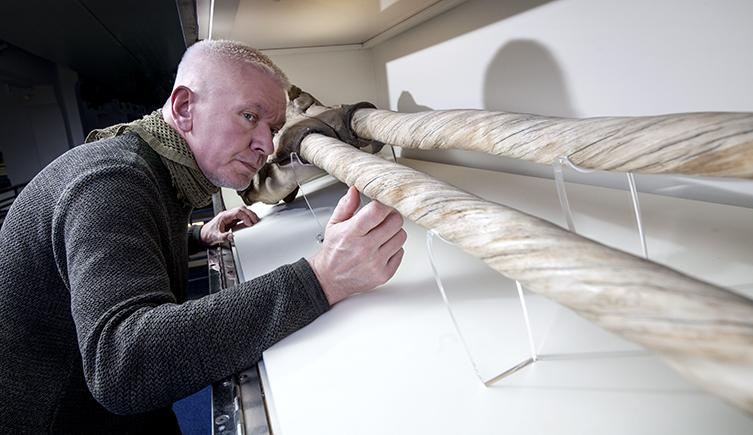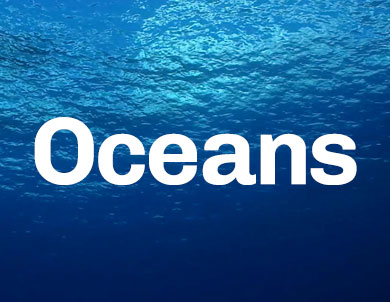Whale earwax reveals just how much human activity can stress out marine mammals
By Katie Pavid
Whales had more cortisol in their bodies while the global whaling industry was at its peak.

By Katie Pavid
Whales had more cortisol in their bodies while the global whaling industry was at its peak.
A new study, published in Nature Communications, showed that fin whales, blue whales and humpback whales experienced a physical stress response when they were hunted on an industrial scale.
Earwax plugs form continually over the lifespan of baleen whales and are made from waxy material deposited in the ear canal. They contain fats and proteins that can reveal the type and quantities of hormones inside a whale's body at various points in its life.
In this study, led by researchers at Baylor University in Texas, the team were particularly interested in cortisol, a hormone that mammals produce at times of stress.
Researchers examined whale earplugs from the Museum's reference collection, the collection of the Smithsonian National Museum of Natural History in the USA and samples taken of recent strandings.

An extracted blue whale plug of earwax measuring 25.4 cm. Image: Trumble et al 2013.
The scientists created lifetime 'stress profiles' of 20 whales from three species: humpback, fin and blue whales. These were some of the most hunted species in the twentieth century, when the global whaling industry boomed.
The profiles resulted in a 146-year dataset, measuring the stress responses of animals from 1870 to 2016.
The whales were particularly stressed during the 1920s and 1930s, at a time of extremely high whale harvests in the northern hemisphere. About 50,000 fin, humpback and blue whales were killed in the 1930s.
Whale earwax can reveal a whale's age, the environmental pollutants it has been exposed to and the hormonal responses throughout its life.
Richard Sabin, curator of marine mammals at the Museum, helped the researchers to access the historic whale collections held in London, which include the precious earplugs.
He says, 'In the middle of the twentieth century, Natural History Museum scientists showed that baleen whale earplugs could be used to determine how old an animal was when it died.
'This was an important step forward, as it allowed more accurate estimates to be made of the ages of animals taken by commercial whaling activities. Earplugs had been of interest to scientists since the start of the century.
'Fortunately, very early examples exist in the collections at the Museum, and it was one of these - from a North Atlantic fin whale estimated to have lived from about 1870 to 1909 - which became the oldest earplug examined as part of this latest research. This allowed the project to extend its study back into the nineteenth century.'
The Museum contributed eight earplugs from its research collection for this study, covering the period from 1870 to 1956.
Richard adds, 'This research really shows the power and significance of archived natural history collections. Each year, new analytical techniques allow more information to be extracted from the often centuries-old preserved remains of museum specimens.'
It isn't just whaling that has had an impact on cetaceans. Baleen whales have also been subjected to other anthropogenic disturbances over the last 100 years, including shipping traffic and increased fishing.
The study also showed that the Second World War (1939-1945) provoked a stress response from the animals. Commercial hunting had slowed dramatically at the time, but researchers found that the cortisol levels in whales kept increasing.
The data suggests that naval battles and underwater bombs, for example, are just as difficult for baleen whales to deal with. Wartime activities may have simply replaced the whaling industry as a source of stress.
Baleen whales may be particularly affected during a period of global conflict because they migrate so far around the world during their lifetimes, increasing the chances of them coming into contact with battles at sea.

Richard Sabin, whale curator at the Museum, looks after cetacean collections that include blue whales, humpback whales and fin whales.
Stress levels in the studied group peaked in the 1960s during the post-war period, when whaling began again in earnest.
Many whale populations were given a lifeline in the mid-1970s, when moratoriums were introduced that banned commercial hunting. Whaling harvests decreased by 75% for fin, blue and humpback whales. The researchers found a corresponding decrease in cortisol levels.
However, after this short period of relief, the team found that cortisol levels began gradually increasing again from 1970 to 2016. As well as more shipping traffic and ocean pollution, rising sea temperatures could be the culprit.
Noise pollution doesn't kill whales, but it can hugely affect their lives. Such disturbances are called 'sub-lethal' stressors. Conservationists find tracking these stressors a challenge, especially in elusive, long-lived animals such as whales. Taking samples and creating a long-term dataset is difficult.
This is where Museum collections can step in to help. Most of the samples used in this study were taken from earplugs preserved in collections, which contain examples of whales found all over the world.
The new paper represents the longest record of stress in baleen whales to date, and so gives scientists an opportunity to model the possible influence of many different factors.
The latest research was led by Dr Stephen Trumble, Associate Professor of Biology at Baylor University.He says, 'We now know that whales are affected by what's going on around them, on a global scale.
'Since we can measure hormones and other chemicals in earplugs, this ultimately will provide us a way to assess the cumulative effects of multiple stressors in these large ocean sentinels.
'For instance, this paper shows there is stress related to whaling, which includes everything from sound to the proximity of the animals to direct harvest. It is now up to managers, governments and agencies to put measures in place that protect these animals.'
Richard adds, 'How incredible it is to be part of a study which shows not only the stressful effects of commercial whaling, but also the ongoing stress caused by other anthropogenic activities. It really demonstrates the importance of combining long-term datasets to help us understand the causes and effects of our actions on the natural world.'

Find out more about life underwater and read about the pioneering work of the Museum's marine scientists.

Taking small, actionable steps can have a big impact when it comes to helping the planet.
Don't miss a thing
Receive email updates about our news, science, exhibitions, events, products, services and fundraising activities. We may occasionally include third-party content from our corporate partners and other museums. We will not share your personal details with these third parties. You must be over the age of 13. Privacy notice.
Follow us on social media